Organisational Behaviour: Motivation, Teams, and Power at John Lewis
VerifiedAdded on 2023/01/11
|19
|5623
|72
Report
AI Summary
This report provides a comprehensive analysis of organisational behaviour within the John Lewis Partnership. It begins with an introduction to the concept of organisational behaviour and its significance in achieving company goals. The report delves into the impact of organisational culture, power, and politics on individual and team behaviour, highlighting how these factors influence performance. It then explores various motivational theories, including Vroom's Expectancy Theory and Herzberg's Two-Factor Theory, and discusses practical motivational techniques, such as intrinsic and extrinsic factors. The report further examines the characteristics of effective versus ineffective teams, emphasizing the importance of cooperation and company culture. Finally, it discusses the application of organisational behaviour concepts and philosophies within John Lewis, focusing on how the company can enhance its operational strengths through innovation and employee commitment. The report concludes by summarizing the key findings and their implications for the company's success.
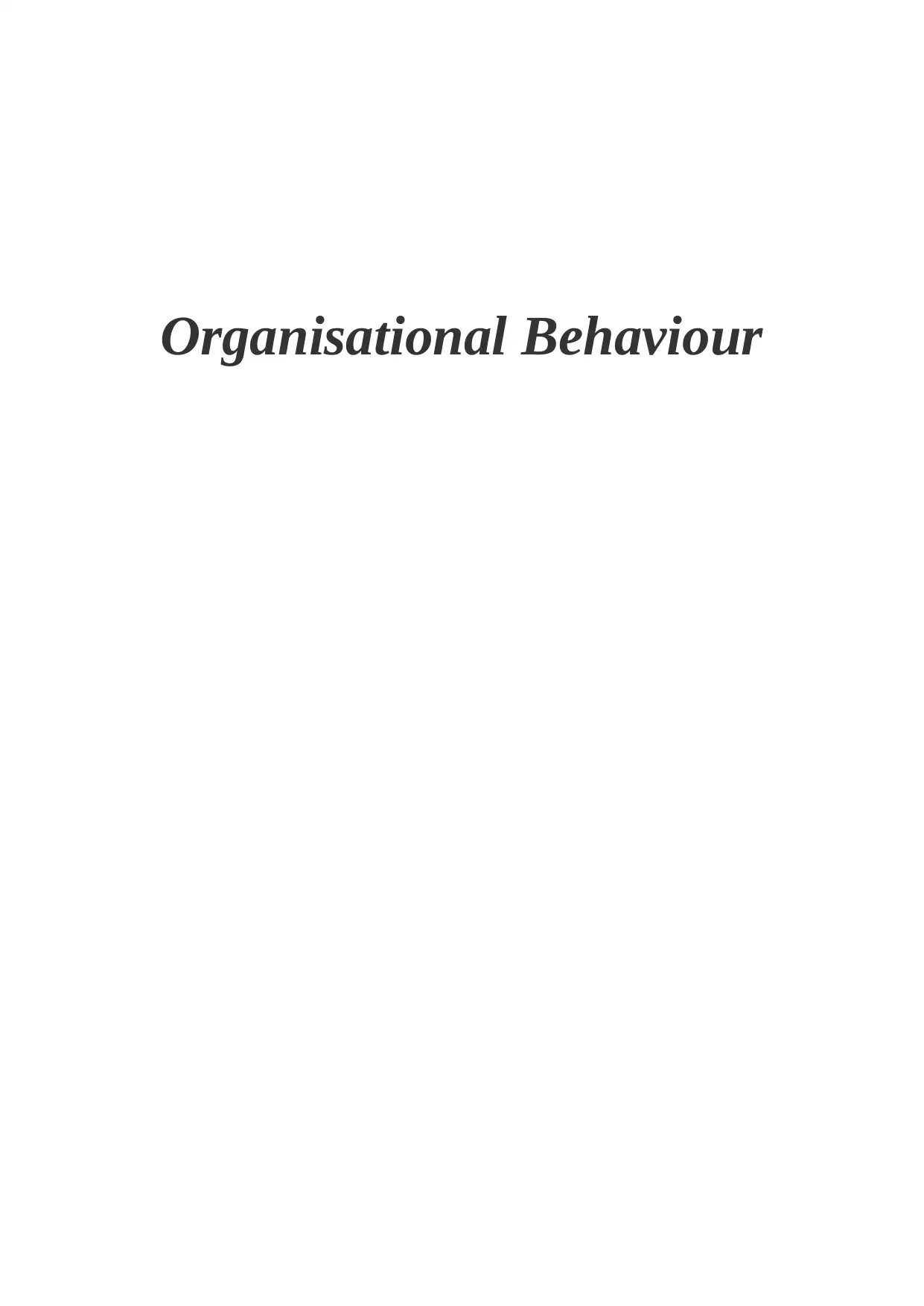
Organisational Behaviour
Paraphrase This Document
Need a fresh take? Get an instant paraphrase of this document with our AI Paraphraser
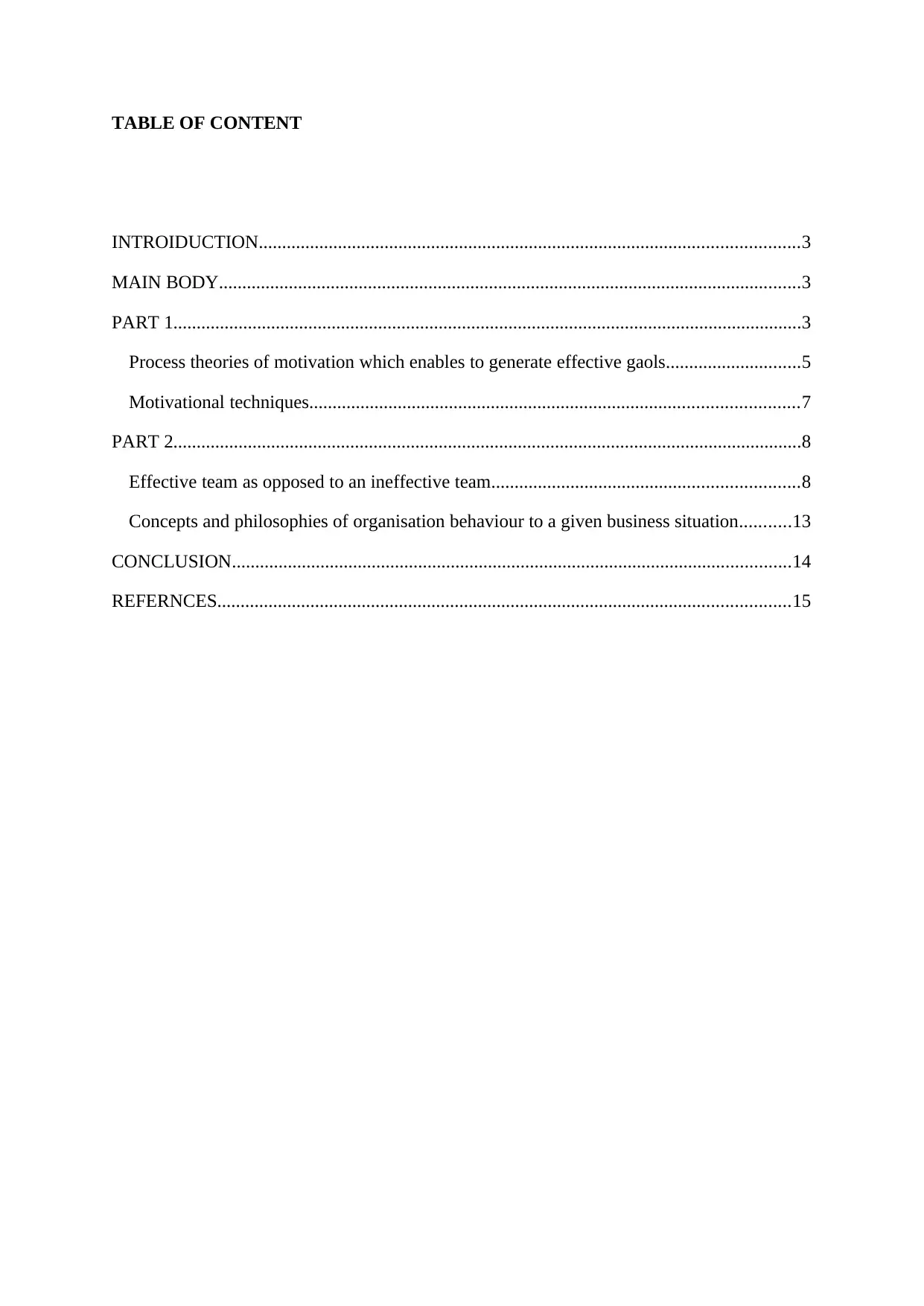
TABLE OF CONTENT
INTROIDUCTION....................................................................................................................3
MAIN BODY.............................................................................................................................3
PART 1.......................................................................................................................................3
Process theories of motivation which enables to generate effective gaols.............................5
Motivational techniques.........................................................................................................7
PART 2.......................................................................................................................................8
Effective team as opposed to an ineffective team..................................................................8
Concepts and philosophies of organisation behaviour to a given business situation...........13
CONCLUSION........................................................................................................................14
REFERNCES...........................................................................................................................15
INTROIDUCTION....................................................................................................................3
MAIN BODY.............................................................................................................................3
PART 1.......................................................................................................................................3
Process theories of motivation which enables to generate effective gaols.............................5
Motivational techniques.........................................................................................................7
PART 2.......................................................................................................................................8
Effective team as opposed to an ineffective team..................................................................8
Concepts and philosophies of organisation behaviour to a given business situation...........13
CONCLUSION........................................................................................................................14
REFERNCES...........................................................................................................................15
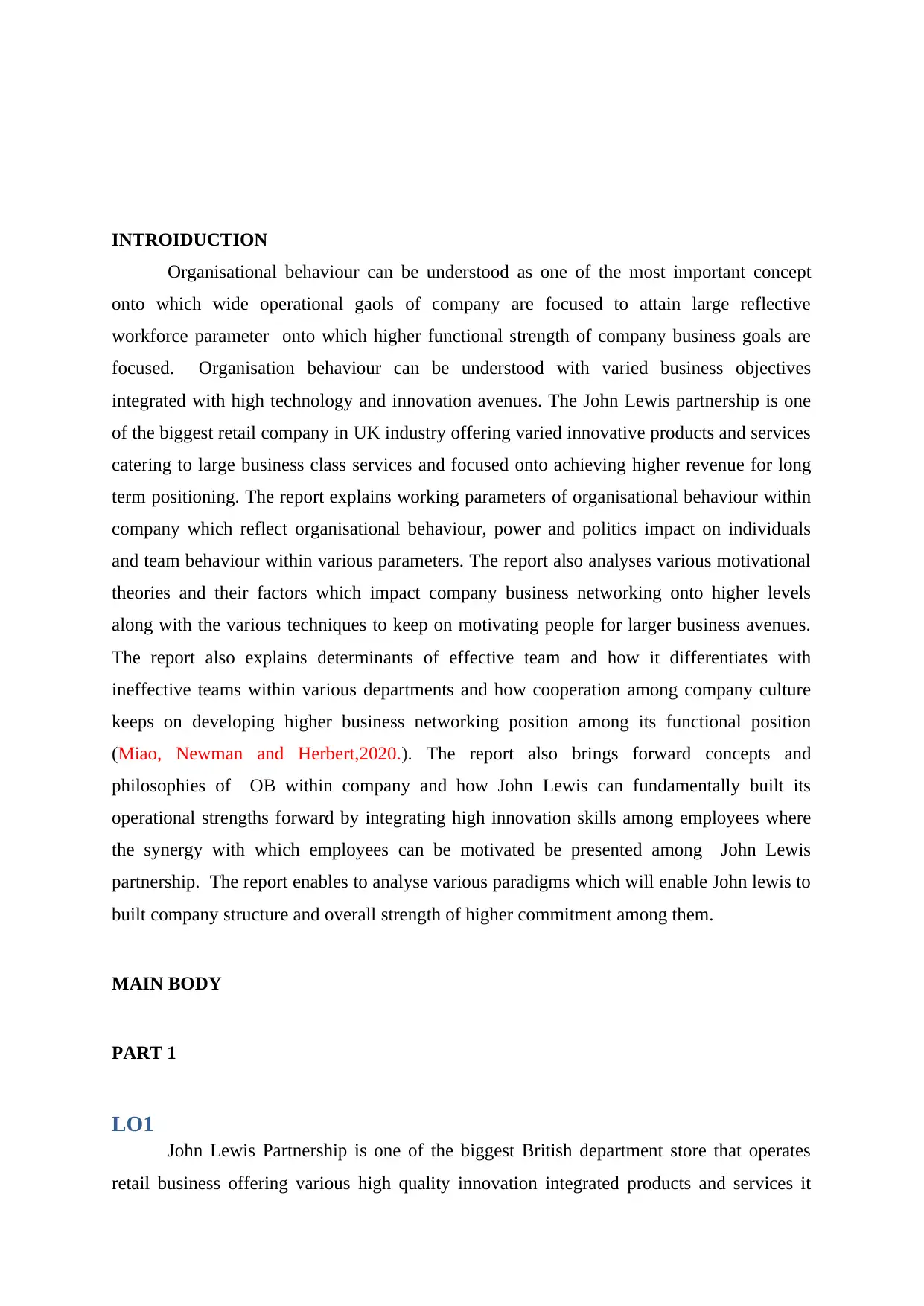
INTROIDUCTION
Organisational behaviour can be understood as one of the most important concept
onto which wide operational gaols of company are focused to attain large reflective
workforce parameter onto which higher functional strength of company business goals are
focused. Organisation behaviour can be understood with varied business objectives
integrated with high technology and innovation avenues. The John Lewis partnership is one
of the biggest retail company in UK industry offering varied innovative products and services
catering to large business class services and focused onto achieving higher revenue for long
term positioning. The report explains working parameters of organisational behaviour within
company which reflect organisational behaviour, power and politics impact on individuals
and team behaviour within various parameters. The report also analyses various motivational
theories and their factors which impact company business networking onto higher levels
along with the various techniques to keep on motivating people for larger business avenues.
The report also explains determinants of effective team and how it differentiates with
ineffective teams within various departments and how cooperation among company culture
keeps on developing higher business networking position among its functional position
(Miao, Newman and Herbert,2020.). The report also brings forward concepts and
philosophies of OB within company and how John Lewis can fundamentally built its
operational strengths forward by integrating high innovation skills among employees where
the synergy with which employees can be motivated be presented among John Lewis
partnership. The report enables to analyse various paradigms which will enable John lewis to
built company structure and overall strength of higher commitment among them.
MAIN BODY
PART 1
LO1
John Lewis Partnership is one of the biggest British department store that operates
retail business offering various high quality innovation integrated products and services it
Organisational behaviour can be understood as one of the most important concept
onto which wide operational gaols of company are focused to attain large reflective
workforce parameter onto which higher functional strength of company business goals are
focused. Organisation behaviour can be understood with varied business objectives
integrated with high technology and innovation avenues. The John Lewis partnership is one
of the biggest retail company in UK industry offering varied innovative products and services
catering to large business class services and focused onto achieving higher revenue for long
term positioning. The report explains working parameters of organisational behaviour within
company which reflect organisational behaviour, power and politics impact on individuals
and team behaviour within various parameters. The report also analyses various motivational
theories and their factors which impact company business networking onto higher levels
along with the various techniques to keep on motivating people for larger business avenues.
The report also explains determinants of effective team and how it differentiates with
ineffective teams within various departments and how cooperation among company culture
keeps on developing higher business networking position among its functional position
(Miao, Newman and Herbert,2020.). The report also brings forward concepts and
philosophies of OB within company and how John Lewis can fundamentally built its
operational strengths forward by integrating high innovation skills among employees where
the synergy with which employees can be motivated be presented among John Lewis
partnership. The report enables to analyse various paradigms which will enable John lewis to
built company structure and overall strength of higher commitment among them.
MAIN BODY
PART 1
LO1
John Lewis Partnership is one of the biggest British department store that operates
retail business offering various high quality innovation integrated products and services it
⊘ This is a preview!⊘
Do you want full access?
Subscribe today to unlock all pages.

Trusted by 1+ million students worldwide
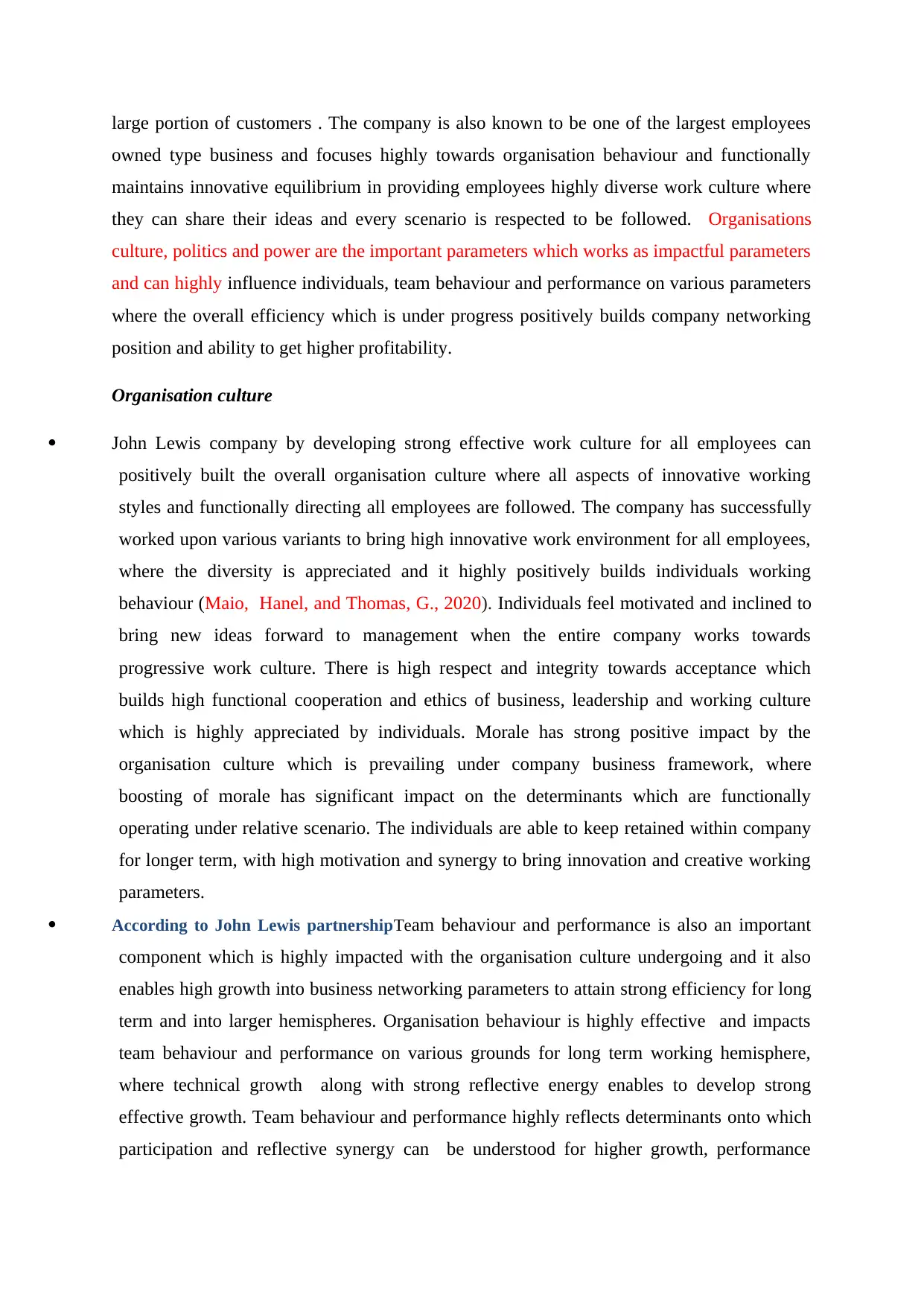
large portion of customers . The company is also known to be one of the largest employees
owned type business and focuses highly towards organisation behaviour and functionally
maintains innovative equilibrium in providing employees highly diverse work culture where
they can share their ideas and every scenario is respected to be followed. Organisations
culture, politics and power are the important parameters which works as impactful parameters
and can highly influence individuals, team behaviour and performance on various parameters
where the overall efficiency which is under progress positively builds company networking
position and ability to get higher profitability.
Organisation culture
John Lewis company by developing strong effective work culture for all employees can
positively built the overall organisation culture where all aspects of innovative working
styles and functionally directing all employees are followed. The company has successfully
worked upon various variants to bring high innovative work environment for all employees,
where the diversity is appreciated and it highly positively builds individuals working
behaviour (Maio, Hanel, and Thomas, G., 2020). Individuals feel motivated and inclined to
bring new ideas forward to management when the entire company works towards
progressive work culture. There is high respect and integrity towards acceptance which
builds high functional cooperation and ethics of business, leadership and working culture
which is highly appreciated by individuals. Morale has strong positive impact by the
organisation culture which is prevailing under company business framework, where
boosting of morale has significant impact on the determinants which are functionally
operating under relative scenario. The individuals are able to keep retained within company
for longer term, with high motivation and synergy to bring innovation and creative working
parameters.
According to John Lewis partnershipTeam behaviour and performance is also an important
component which is highly impacted with the organisation culture undergoing and it also
enables high growth into business networking parameters to attain strong efficiency for long
term and into larger hemispheres. Organisation behaviour is highly effective and impacts
team behaviour and performance on various grounds for long term working hemisphere,
where technical growth along with strong reflective energy enables to develop strong
effective growth. Team behaviour and performance highly reflects determinants onto which
participation and reflective synergy can be understood for higher growth, performance
owned type business and focuses highly towards organisation behaviour and functionally
maintains innovative equilibrium in providing employees highly diverse work culture where
they can share their ideas and every scenario is respected to be followed. Organisations
culture, politics and power are the important parameters which works as impactful parameters
and can highly influence individuals, team behaviour and performance on various parameters
where the overall efficiency which is under progress positively builds company networking
position and ability to get higher profitability.
Organisation culture
John Lewis company by developing strong effective work culture for all employees can
positively built the overall organisation culture where all aspects of innovative working
styles and functionally directing all employees are followed. The company has successfully
worked upon various variants to bring high innovative work environment for all employees,
where the diversity is appreciated and it highly positively builds individuals working
behaviour (Maio, Hanel, and Thomas, G., 2020). Individuals feel motivated and inclined to
bring new ideas forward to management when the entire company works towards
progressive work culture. There is high respect and integrity towards acceptance which
builds high functional cooperation and ethics of business, leadership and working culture
which is highly appreciated by individuals. Morale has strong positive impact by the
organisation culture which is prevailing under company business framework, where
boosting of morale has significant impact on the determinants which are functionally
operating under relative scenario. The individuals are able to keep retained within company
for longer term, with high motivation and synergy to bring innovation and creative working
parameters.
According to John Lewis partnershipTeam behaviour and performance is also an important
component which is highly impacted with the organisation culture undergoing and it also
enables high growth into business networking parameters to attain strong efficiency for long
term and into larger hemispheres. Organisation behaviour is highly effective and impacts
team behaviour and performance on various grounds for long term working hemisphere,
where technical growth along with strong reflective energy enables to develop strong
effective growth. Team behaviour and performance highly reflects determinants onto which
participation and reflective synergy can be understood for higher growth, performance
Paraphrase This Document
Need a fresh take? Get an instant paraphrase of this document with our AI Paraphraser
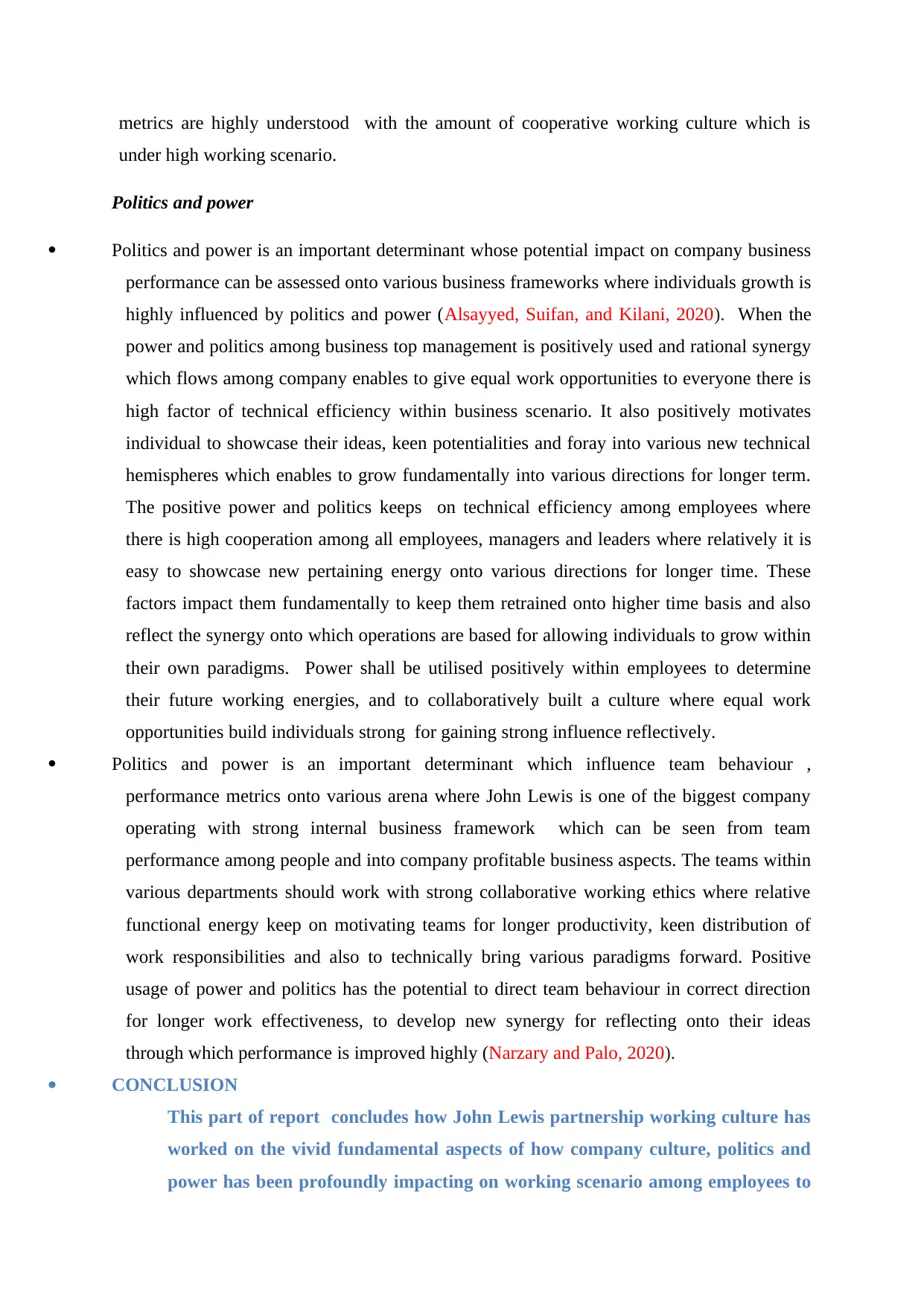
metrics are highly understood with the amount of cooperative working culture which is
under high working scenario.
Politics and power
Politics and power is an important determinant whose potential impact on company business
performance can be assessed onto various business frameworks where individuals growth is
highly influenced by politics and power (Alsayyed, Suifan, and Kilani, 2020). When the
power and politics among business top management is positively used and rational synergy
which flows among company enables to give equal work opportunities to everyone there is
high factor of technical efficiency within business scenario. It also positively motivates
individual to showcase their ideas, keen potentialities and foray into various new technical
hemispheres which enables to grow fundamentally into various directions for longer term.
The positive power and politics keeps on technical efficiency among employees where
there is high cooperation among all employees, managers and leaders where relatively it is
easy to showcase new pertaining energy onto various directions for longer time. These
factors impact them fundamentally to keep them retrained onto higher time basis and also
reflect the synergy onto which operations are based for allowing individuals to grow within
their own paradigms. Power shall be utilised positively within employees to determine
their future working energies, and to collaboratively built a culture where equal work
opportunities build individuals strong for gaining strong influence reflectively.
Politics and power is an important determinant which influence team behaviour ,
performance metrics onto various arena where John Lewis is one of the biggest company
operating with strong internal business framework which can be seen from team
performance among people and into company profitable business aspects. The teams within
various departments should work with strong collaborative working ethics where relative
functional energy keep on motivating teams for longer productivity, keen distribution of
work responsibilities and also to technically bring various paradigms forward. Positive
usage of power and politics has the potential to direct team behaviour in correct direction
for longer work effectiveness, to develop new synergy for reflecting onto their ideas
through which performance is improved highly (Narzary and Palo, 2020).
CONCLUSION
This part of report concludes how John Lewis partnership working culture has
worked on the vivid fundamental aspects of how company culture, politics and
power has been profoundly impacting on working scenario among employees to
under high working scenario.
Politics and power
Politics and power is an important determinant whose potential impact on company business
performance can be assessed onto various business frameworks where individuals growth is
highly influenced by politics and power (Alsayyed, Suifan, and Kilani, 2020). When the
power and politics among business top management is positively used and rational synergy
which flows among company enables to give equal work opportunities to everyone there is
high factor of technical efficiency within business scenario. It also positively motivates
individual to showcase their ideas, keen potentialities and foray into various new technical
hemispheres which enables to grow fundamentally into various directions for longer term.
The positive power and politics keeps on technical efficiency among employees where
there is high cooperation among all employees, managers and leaders where relatively it is
easy to showcase new pertaining energy onto various directions for longer time. These
factors impact them fundamentally to keep them retrained onto higher time basis and also
reflect the synergy onto which operations are based for allowing individuals to grow within
their own paradigms. Power shall be utilised positively within employees to determine
their future working energies, and to collaboratively built a culture where equal work
opportunities build individuals strong for gaining strong influence reflectively.
Politics and power is an important determinant which influence team behaviour ,
performance metrics onto various arena where John Lewis is one of the biggest company
operating with strong internal business framework which can be seen from team
performance among people and into company profitable business aspects. The teams within
various departments should work with strong collaborative working ethics where relative
functional energy keep on motivating teams for longer productivity, keen distribution of
work responsibilities and also to technically bring various paradigms forward. Positive
usage of power and politics has the potential to direct team behaviour in correct direction
for longer work effectiveness, to develop new synergy for reflecting onto their ideas
through which performance is improved highly (Narzary and Palo, 2020).
CONCLUSION
This part of report concludes how John Lewis partnership working culture has
worked on the vivid fundamental aspects of how company culture, politics and
power has been profoundly impacting on working scenario among employees to
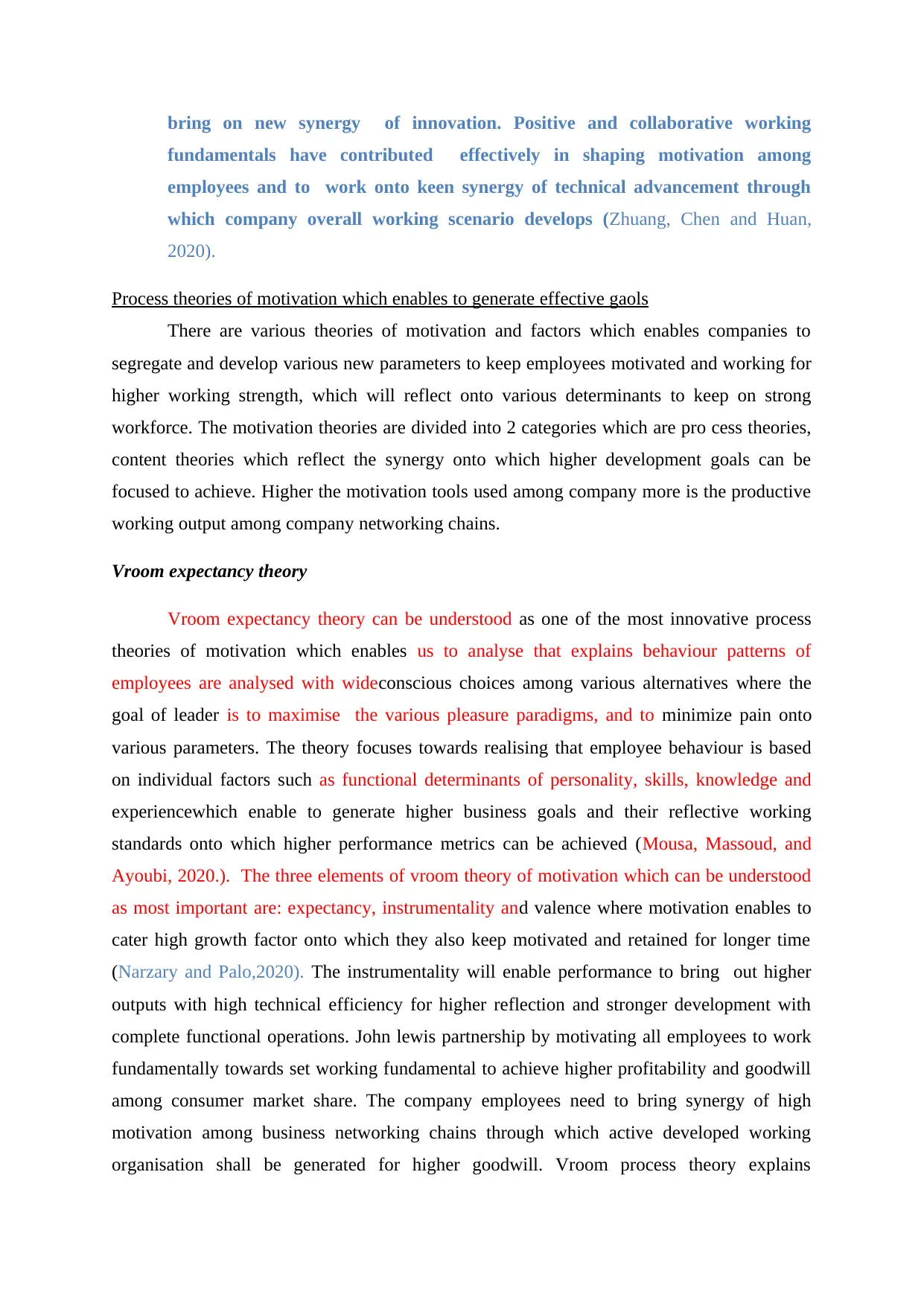
bring on new synergy of innovation. Positive and collaborative working
fundamentals have contributed effectively in shaping motivation among
employees and to work onto keen synergy of technical advancement through
which company overall working scenario develops (Zhuang, Chen and Huan,
2020).
Process theories of motivation which enables to generate effective gaols
There are various theories of motivation and factors which enables companies to
segregate and develop various new parameters to keep employees motivated and working for
higher working strength, which will reflect onto various determinants to keep on strong
workforce. The motivation theories are divided into 2 categories which are pro cess theories,
content theories which reflect the synergy onto which higher development goals can be
focused to achieve. Higher the motivation tools used among company more is the productive
working output among company networking chains.
Vroom expectancy theory
Vroom expectancy theory can be understood as one of the most innovative process
theories of motivation which enables us to analyse that explains behaviour patterns of
employees are analysed with wideconscious choices among various alternatives where the
goal of leader is to maximise the various pleasure paradigms, and to minimize pain onto
various parameters. The theory focuses towards realising that employee behaviour is based
on individual factors such as functional determinants of personality, skills, knowledge and
experiencewhich enable to generate higher business goals and their reflective working
standards onto which higher performance metrics can be achieved (Mousa, Massoud, and
Ayoubi, 2020.). The three elements of vroom theory of motivation which can be understood
as most important are: expectancy, instrumentality and valence where motivation enables to
cater high growth factor onto which they also keep motivated and retained for longer time
(Narzary and Palo,2020). The instrumentality will enable performance to bring out higher
outputs with high technical efficiency for higher reflection and stronger development with
complete functional operations. John lewis partnership by motivating all employees to work
fundamentally towards set working fundamental to achieve higher profitability and goodwill
among consumer market share. The company employees need to bring synergy of high
motivation among business networking chains through which active developed working
organisation shall be generated for higher goodwill. Vroom process theory explains
fundamentals have contributed effectively in shaping motivation among
employees and to work onto keen synergy of technical advancement through
which company overall working scenario develops (Zhuang, Chen and Huan,
2020).
Process theories of motivation which enables to generate effective gaols
There are various theories of motivation and factors which enables companies to
segregate and develop various new parameters to keep employees motivated and working for
higher working strength, which will reflect onto various determinants to keep on strong
workforce. The motivation theories are divided into 2 categories which are pro cess theories,
content theories which reflect the synergy onto which higher development goals can be
focused to achieve. Higher the motivation tools used among company more is the productive
working output among company networking chains.
Vroom expectancy theory
Vroom expectancy theory can be understood as one of the most innovative process
theories of motivation which enables us to analyse that explains behaviour patterns of
employees are analysed with wideconscious choices among various alternatives where the
goal of leader is to maximise the various pleasure paradigms, and to minimize pain onto
various parameters. The theory focuses towards realising that employee behaviour is based
on individual factors such as functional determinants of personality, skills, knowledge and
experiencewhich enable to generate higher business goals and their reflective working
standards onto which higher performance metrics can be achieved (Mousa, Massoud, and
Ayoubi, 2020.). The three elements of vroom theory of motivation which can be understood
as most important are: expectancy, instrumentality and valence where motivation enables to
cater high growth factor onto which they also keep motivated and retained for longer time
(Narzary and Palo,2020). The instrumentality will enable performance to bring out higher
outputs with high technical efficiency for higher reflection and stronger development with
complete functional operations. John lewis partnership by motivating all employees to work
fundamentally towards set working fundamental to achieve higher profitability and goodwill
among consumer market share. The company employees need to bring synergy of high
motivation among business networking chains through which active developed working
organisation shall be generated for higher goodwill. Vroom process theory explains
⊘ This is a preview!⊘
Do you want full access?
Subscribe today to unlock all pages.

Trusted by 1+ million students worldwide
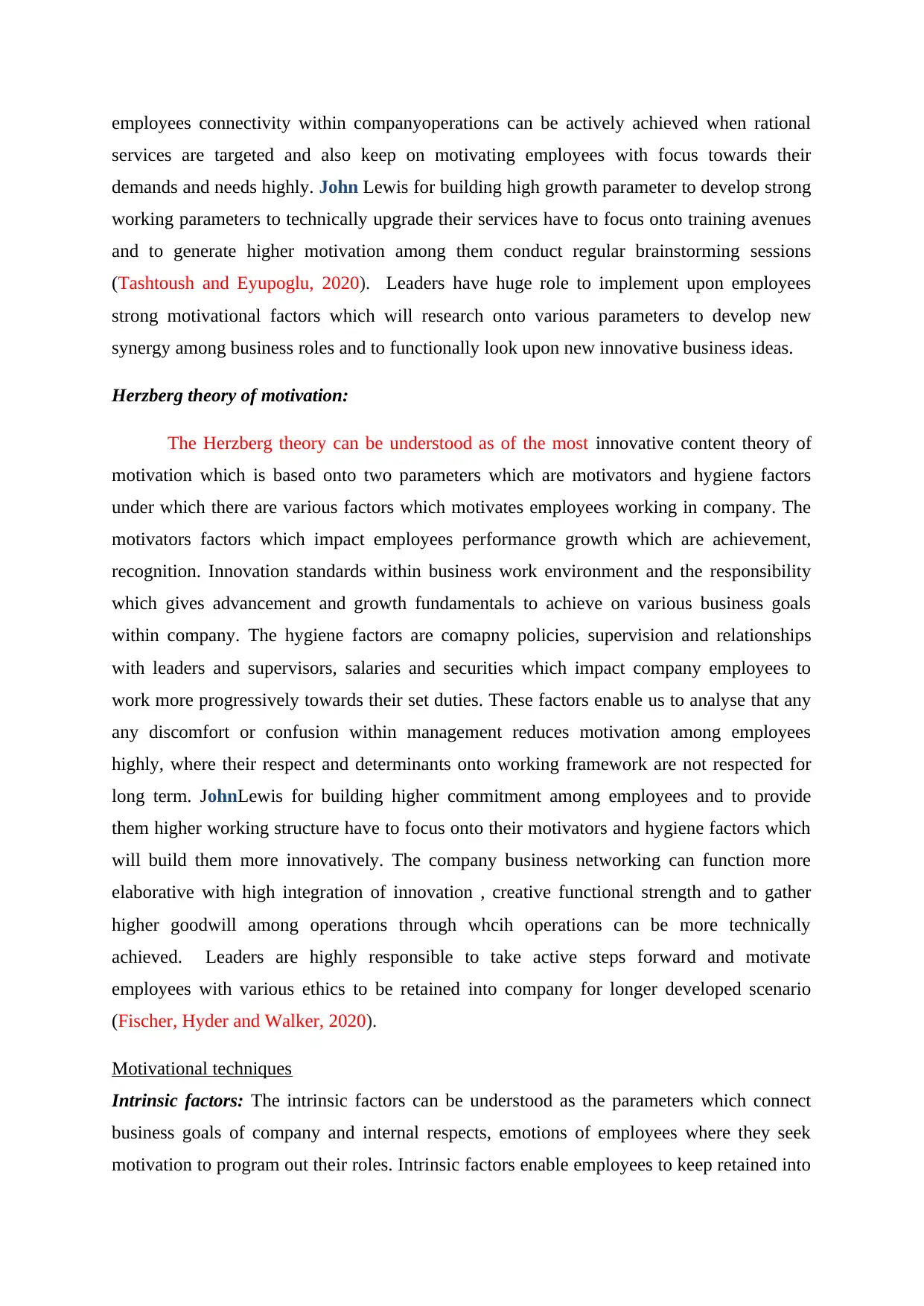
employees connectivity within companyoperations can be actively achieved when rational
services are targeted and also keep on motivating employees with focus towards their
demands and needs highly. John Lewis for building high growth parameter to develop strong
working parameters to technically upgrade their services have to focus onto training avenues
and to generate higher motivation among them conduct regular brainstorming sessions
(Tashtoush and Eyupoglu, 2020). Leaders have huge role to implement upon employees
strong motivational factors which will research onto various parameters to develop new
synergy among business roles and to functionally look upon new innovative business ideas.
Herzberg theory of motivation:
The Herzberg theory can be understood as of the most innovative content theory of
motivation which is based onto two parameters which are motivators and hygiene factors
under which there are various factors which motivates employees working in company. The
motivators factors which impact employees performance growth which are achievement,
recognition. Innovation standards within business work environment and the responsibility
which gives advancement and growth fundamentals to achieve on various business goals
within company. The hygiene factors are comapny policies, supervision and relationships
with leaders and supervisors, salaries and securities which impact company employees to
work more progressively towards their set duties. These factors enable us to analyse that any
any discomfort or confusion within management reduces motivation among employees
highly, where their respect and determinants onto working framework are not respected for
long term. JohnLewis for building higher commitment among employees and to provide
them higher working structure have to focus onto their motivators and hygiene factors which
will build them more innovatively. The company business networking can function more
elaborative with high integration of innovation , creative functional strength and to gather
higher goodwill among operations through whcih operations can be more technically
achieved. Leaders are highly responsible to take active steps forward and motivate
employees with various ethics to be retained into company for longer developed scenario
(Fischer, Hyder and Walker, 2020).
Motivational techniques
Intrinsic factors: The intrinsic factors can be understood as the parameters which connect
business goals of company and internal respects, emotions of employees where they seek
motivation to program out their roles. Intrinsic factors enable employees to keep retained into
services are targeted and also keep on motivating employees with focus towards their
demands and needs highly. John Lewis for building high growth parameter to develop strong
working parameters to technically upgrade their services have to focus onto training avenues
and to generate higher motivation among them conduct regular brainstorming sessions
(Tashtoush and Eyupoglu, 2020). Leaders have huge role to implement upon employees
strong motivational factors which will research onto various parameters to develop new
synergy among business roles and to functionally look upon new innovative business ideas.
Herzberg theory of motivation:
The Herzberg theory can be understood as of the most innovative content theory of
motivation which is based onto two parameters which are motivators and hygiene factors
under which there are various factors which motivates employees working in company. The
motivators factors which impact employees performance growth which are achievement,
recognition. Innovation standards within business work environment and the responsibility
which gives advancement and growth fundamentals to achieve on various business goals
within company. The hygiene factors are comapny policies, supervision and relationships
with leaders and supervisors, salaries and securities which impact company employees to
work more progressively towards their set duties. These factors enable us to analyse that any
any discomfort or confusion within management reduces motivation among employees
highly, where their respect and determinants onto working framework are not respected for
long term. JohnLewis for building higher commitment among employees and to provide
them higher working structure have to focus onto their motivators and hygiene factors which
will build them more innovatively. The company business networking can function more
elaborative with high integration of innovation , creative functional strength and to gather
higher goodwill among operations through whcih operations can be more technically
achieved. Leaders are highly responsible to take active steps forward and motivate
employees with various ethics to be retained into company for longer developed scenario
(Fischer, Hyder and Walker, 2020).
Motivational techniques
Intrinsic factors: The intrinsic factors can be understood as the parameters which connect
business goals of company and internal respects, emotions of employees where they seek
motivation to program out their roles. Intrinsic factors enable employees to keep retained into
Paraphrase This Document
Need a fresh take? Get an instant paraphrase of this document with our AI Paraphraser
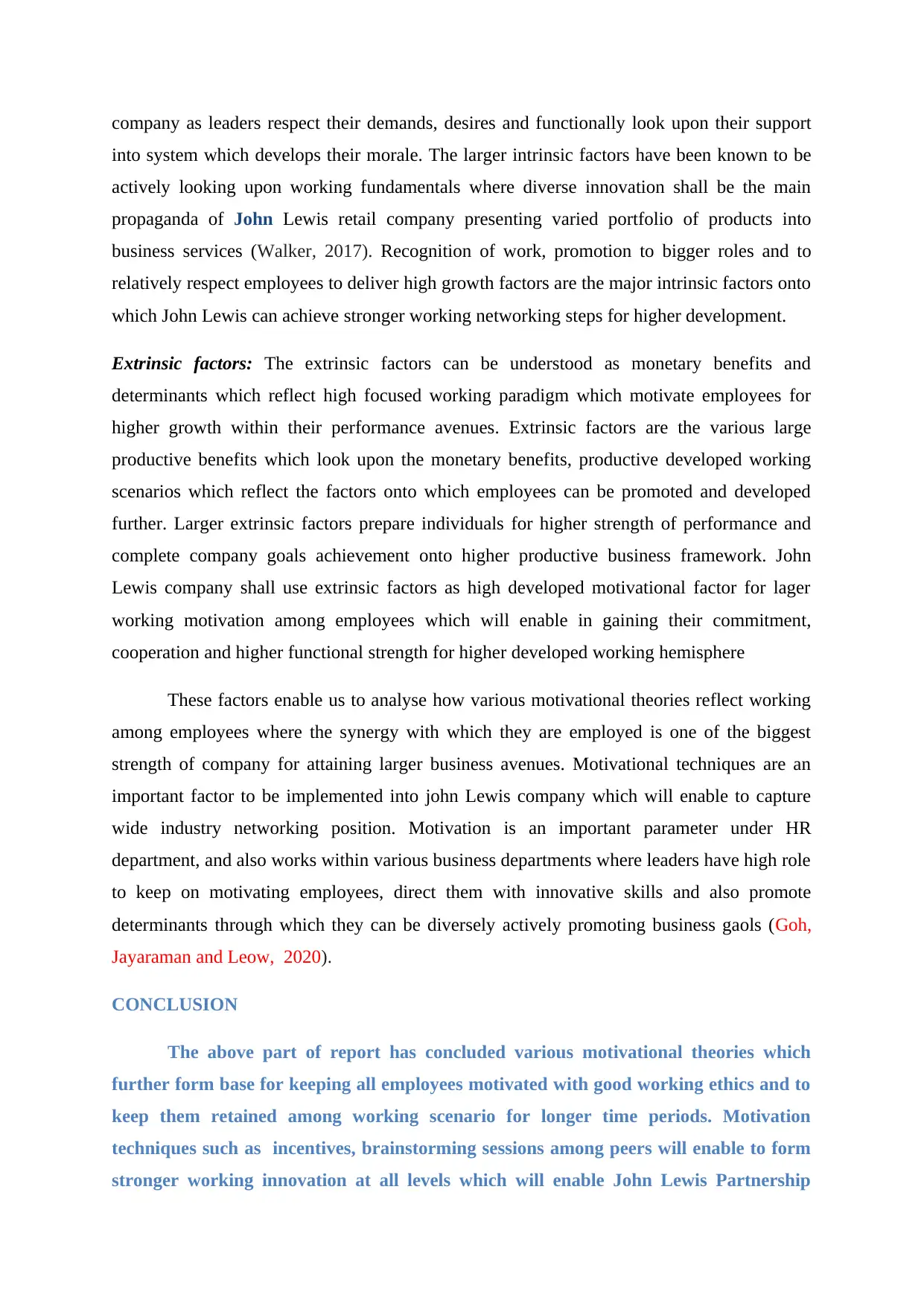
company as leaders respect their demands, desires and functionally look upon their support
into system which develops their morale. The larger intrinsic factors have been known to be
actively looking upon working fundamentals where diverse innovation shall be the main
propaganda of John Lewis retail company presenting varied portfolio of products into
business services (Walker, 2017). Recognition of work, promotion to bigger roles and to
relatively respect employees to deliver high growth factors are the major intrinsic factors onto
which John Lewis can achieve stronger working networking steps for higher development.
Extrinsic factors: The extrinsic factors can be understood as monetary benefits and
determinants which reflect high focused working paradigm which motivate employees for
higher growth within their performance avenues. Extrinsic factors are the various large
productive benefits which look upon the monetary benefits, productive developed working
scenarios which reflect the factors onto which employees can be promoted and developed
further. Larger extrinsic factors prepare individuals for higher strength of performance and
complete company goals achievement onto higher productive business framework. John
Lewis company shall use extrinsic factors as high developed motivational factor for lager
working motivation among employees which will enable in gaining their commitment,
cooperation and higher functional strength for higher developed working hemisphere
These factors enable us to analyse how various motivational theories reflect working
among employees where the synergy with which they are employed is one of the biggest
strength of company for attaining larger business avenues. Motivational techniques are an
important factor to be implemented into john Lewis company which will enable to capture
wide industry networking position. Motivation is an important parameter under HR
department, and also works within various business departments where leaders have high role
to keep on motivating employees, direct them with innovative skills and also promote
determinants through which they can be diversely actively promoting business gaols (Goh,
Jayaraman and Leow, 2020).
CONCLUSION
The above part of report has concluded various motivational theories which
further form base for keeping all employees motivated with good working ethics and to
keep them retained among working scenario for longer time periods. Motivation
techniques such as incentives, brainstorming sessions among peers will enable to form
stronger working innovation at all levels which will enable John Lewis Partnership
into system which develops their morale. The larger intrinsic factors have been known to be
actively looking upon working fundamentals where diverse innovation shall be the main
propaganda of John Lewis retail company presenting varied portfolio of products into
business services (Walker, 2017). Recognition of work, promotion to bigger roles and to
relatively respect employees to deliver high growth factors are the major intrinsic factors onto
which John Lewis can achieve stronger working networking steps for higher development.
Extrinsic factors: The extrinsic factors can be understood as monetary benefits and
determinants which reflect high focused working paradigm which motivate employees for
higher growth within their performance avenues. Extrinsic factors are the various large
productive benefits which look upon the monetary benefits, productive developed working
scenarios which reflect the factors onto which employees can be promoted and developed
further. Larger extrinsic factors prepare individuals for higher strength of performance and
complete company goals achievement onto higher productive business framework. John
Lewis company shall use extrinsic factors as high developed motivational factor for lager
working motivation among employees which will enable in gaining their commitment,
cooperation and higher functional strength for higher developed working hemisphere
These factors enable us to analyse how various motivational theories reflect working
among employees where the synergy with which they are employed is one of the biggest
strength of company for attaining larger business avenues. Motivational techniques are an
important factor to be implemented into john Lewis company which will enable to capture
wide industry networking position. Motivation is an important parameter under HR
department, and also works within various business departments where leaders have high role
to keep on motivating employees, direct them with innovative skills and also promote
determinants through which they can be diversely actively promoting business gaols (Goh,
Jayaraman and Leow, 2020).
CONCLUSION
The above part of report has concluded various motivational theories which
further form base for keeping all employees motivated with good working ethics and to
keep them retained among working scenario for longer time periods. Motivation
techniques such as incentives, brainstorming sessions among peers will enable to form
stronger working innovation at all levels which will enable John Lewis Partnership
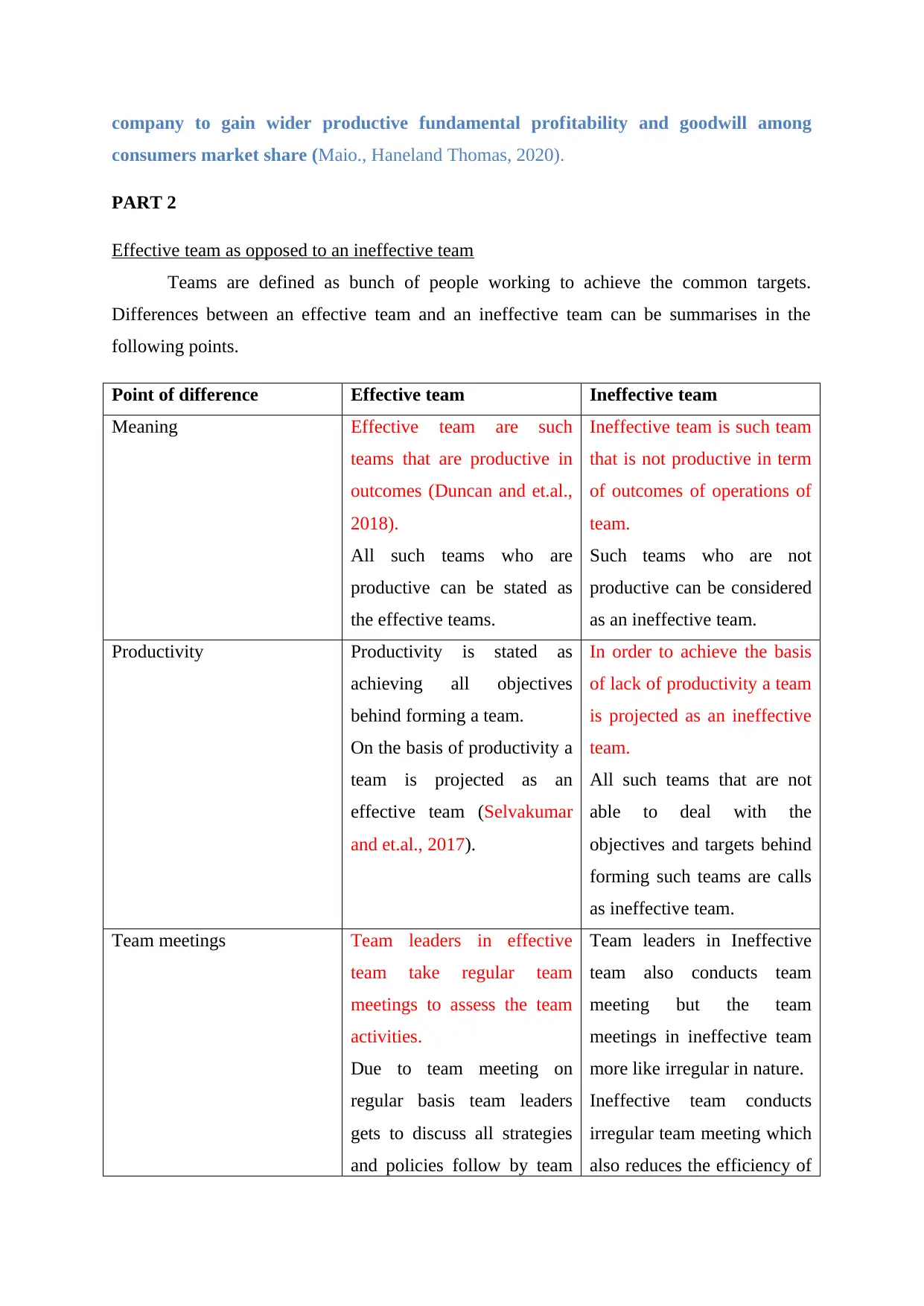
company to gain wider productive fundamental profitability and goodwill among
consumers market share (Maio., Haneland Thomas, 2020).
PART 2
Effective team as opposed to an ineffective team
Teams are defined as bunch of people working to achieve the common targets.
Differences between an effective team and an ineffective team can be summarises in the
following points.
Point of difference Effective team Ineffective team
Meaning Effective team are such
teams that are productive in
outcomes (Duncan and et.al.,
2018).
All such teams who are
productive can be stated as
the effective teams.
Ineffective team is such team
that is not productive in term
of outcomes of operations of
team.
Such teams who are not
productive can be considered
as an ineffective team.
Productivity Productivity is stated as
achieving all objectives
behind forming a team.
On the basis of productivity a
team is projected as an
effective team (Selvakumar
and et.al., 2017).
In order to achieve the basis
of lack of productivity a team
is projected as an ineffective
team.
All such teams that are not
able to deal with the
objectives and targets behind
forming such teams are calls
as ineffective team.
Team meetings Team leaders in effective
team take regular team
meetings to assess the team
activities.
Due to team meeting on
regular basis team leaders
gets to discuss all strategies
and policies follow by team
Team leaders in Ineffective
team also conducts team
meeting but the team
meetings in ineffective team
more like irregular in nature.
Ineffective team conducts
irregular team meeting which
also reduces the efficiency of
consumers market share (Maio., Haneland Thomas, 2020).
PART 2
Effective team as opposed to an ineffective team
Teams are defined as bunch of people working to achieve the common targets.
Differences between an effective team and an ineffective team can be summarises in the
following points.
Point of difference Effective team Ineffective team
Meaning Effective team are such
teams that are productive in
outcomes (Duncan and et.al.,
2018).
All such teams who are
productive can be stated as
the effective teams.
Ineffective team is such team
that is not productive in term
of outcomes of operations of
team.
Such teams who are not
productive can be considered
as an ineffective team.
Productivity Productivity is stated as
achieving all objectives
behind forming a team.
On the basis of productivity a
team is projected as an
effective team (Selvakumar
and et.al., 2017).
In order to achieve the basis
of lack of productivity a team
is projected as an ineffective
team.
All such teams that are not
able to deal with the
objectives and targets behind
forming such teams are calls
as ineffective team.
Team meetings Team leaders in effective
team take regular team
meetings to assess the team
activities.
Due to team meeting on
regular basis team leaders
gets to discuss all strategies
and policies follow by team
Team leaders in Ineffective
team also conducts team
meeting but the team
meetings in ineffective team
more like irregular in nature.
Ineffective team conducts
irregular team meeting which
also reduces the efficiency of
⊘ This is a preview!⊘
Do you want full access?
Subscribe today to unlock all pages.

Trusted by 1+ million students worldwide
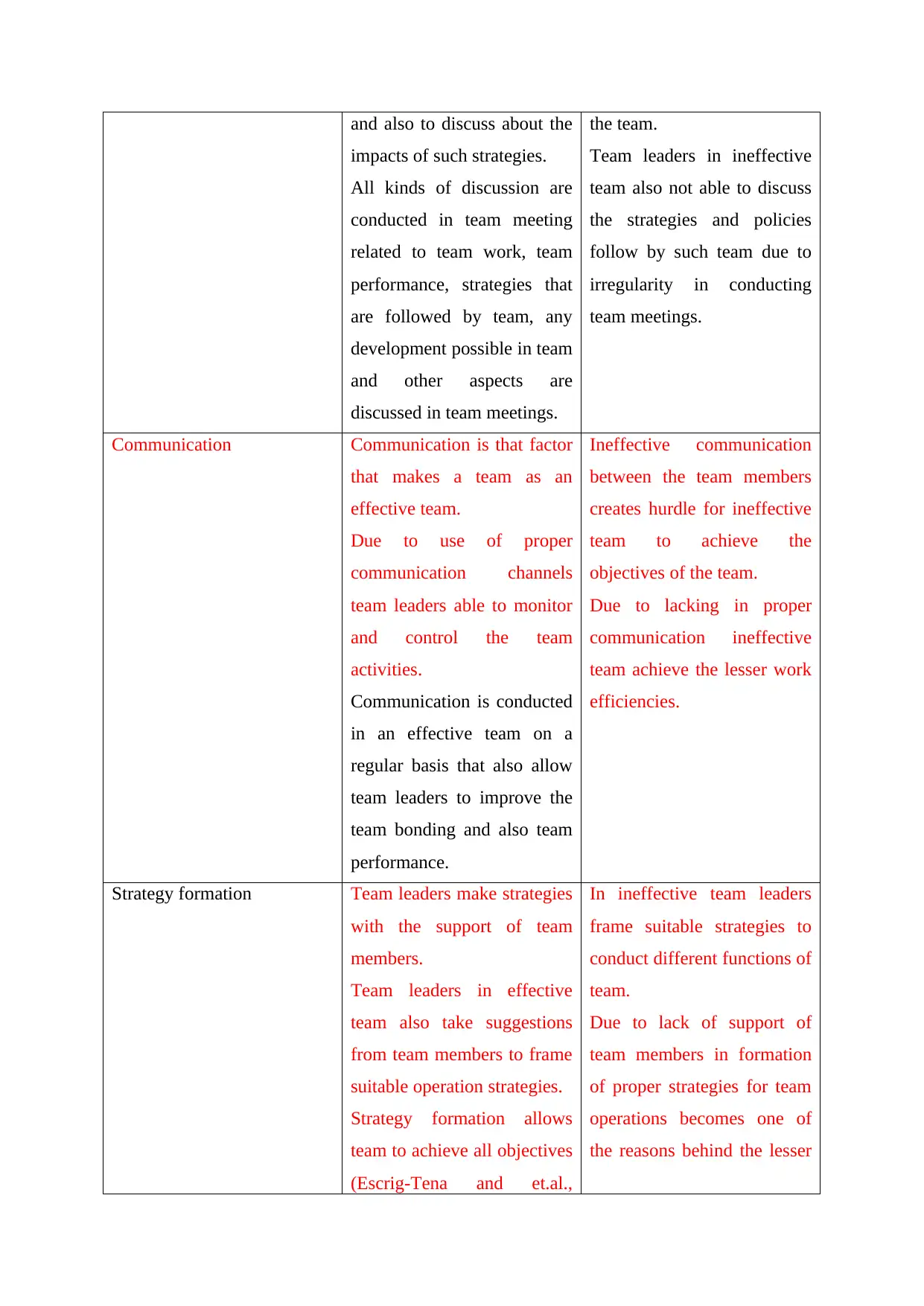
and also to discuss about the
impacts of such strategies.
All kinds of discussion are
conducted in team meeting
related to team work, team
performance, strategies that
are followed by team, any
development possible in team
and other aspects are
discussed in team meetings.
the team.
Team leaders in ineffective
team also not able to discuss
the strategies and policies
follow by such team due to
irregularity in conducting
team meetings.
Communication Communication is that factor
that makes a team as an
effective team.
Due to use of proper
communication channels
team leaders able to monitor
and control the team
activities.
Communication is conducted
in an effective team on a
regular basis that also allow
team leaders to improve the
team bonding and also team
performance.
Ineffective communication
between the team members
creates hurdle for ineffective
team to achieve the
objectives of the team.
Due to lacking in proper
communication ineffective
team achieve the lesser work
efficiencies.
Strategy formation Team leaders make strategies
with the support of team
members.
Team leaders in effective
team also take suggestions
from team members to frame
suitable operation strategies.
Strategy formation allows
team to achieve all objectives
(Escrig-Tena and et.al.,
In ineffective team leaders
frame suitable strategies to
conduct different functions of
team.
Due to lack of support of
team members in formation
of proper strategies for team
operations becomes one of
the reasons behind the lesser
impacts of such strategies.
All kinds of discussion are
conducted in team meeting
related to team work, team
performance, strategies that
are followed by team, any
development possible in team
and other aspects are
discussed in team meetings.
the team.
Team leaders in ineffective
team also not able to discuss
the strategies and policies
follow by such team due to
irregularity in conducting
team meetings.
Communication Communication is that factor
that makes a team as an
effective team.
Due to use of proper
communication channels
team leaders able to monitor
and control the team
activities.
Communication is conducted
in an effective team on a
regular basis that also allow
team leaders to improve the
team bonding and also team
performance.
Ineffective communication
between the team members
creates hurdle for ineffective
team to achieve the
objectives of the team.
Due to lacking in proper
communication ineffective
team achieve the lesser work
efficiencies.
Strategy formation Team leaders make strategies
with the support of team
members.
Team leaders in effective
team also take suggestions
from team members to frame
suitable operation strategies.
Strategy formation allows
team to achieve all objectives
(Escrig-Tena and et.al.,
In ineffective team leaders
frame suitable strategies to
conduct different functions of
team.
Due to lack of support of
team members in formation
of proper strategies for team
operations becomes one of
the reasons behind the lesser
Paraphrase This Document
Need a fresh take? Get an instant paraphrase of this document with our AI Paraphraser
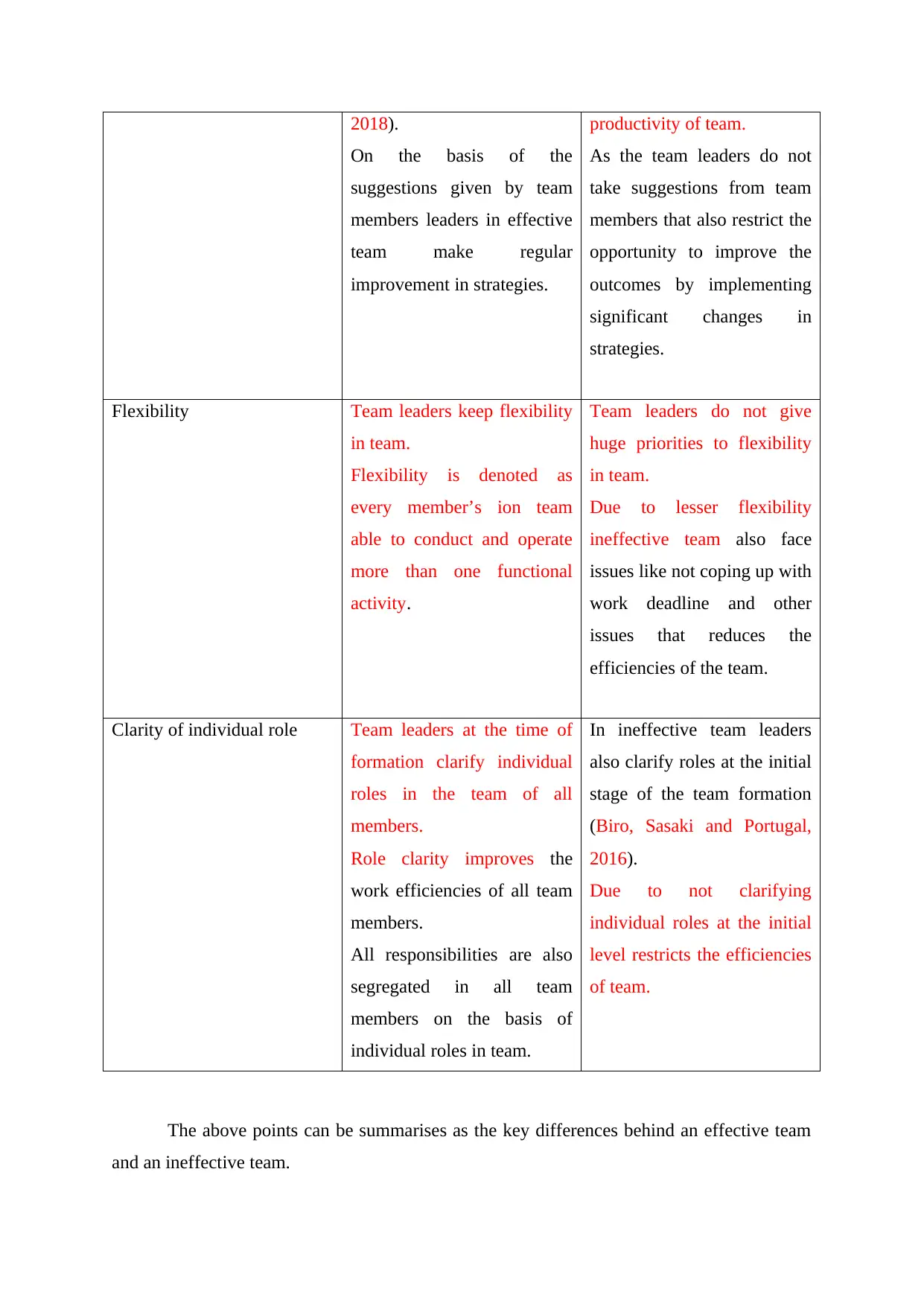
2018).
On the basis of the
suggestions given by team
members leaders in effective
team make regular
improvement in strategies.
productivity of team.
As the team leaders do not
take suggestions from team
members that also restrict the
opportunity to improve the
outcomes by implementing
significant changes in
strategies.
Flexibility Team leaders keep flexibility
in team.
Flexibility is denoted as
every member’s ion team
able to conduct and operate
more than one functional
activity.
Team leaders do not give
huge priorities to flexibility
in team.
Due to lesser flexibility
ineffective team also face
issues like not coping up with
work deadline and other
issues that reduces the
efficiencies of the team.
Clarity of individual role Team leaders at the time of
formation clarify individual
roles in the team of all
members.
Role clarity improves the
work efficiencies of all team
members.
All responsibilities are also
segregated in all team
members on the basis of
individual roles in team.
In ineffective team leaders
also clarify roles at the initial
stage of the team formation
(Biro, Sasaki and Portugal,
2016).
Due to not clarifying
individual roles at the initial
level restricts the efficiencies
of team.
The above points can be summarises as the key differences behind an effective team
and an ineffective team.
On the basis of the
suggestions given by team
members leaders in effective
team make regular
improvement in strategies.
productivity of team.
As the team leaders do not
take suggestions from team
members that also restrict the
opportunity to improve the
outcomes by implementing
significant changes in
strategies.
Flexibility Team leaders keep flexibility
in team.
Flexibility is denoted as
every member’s ion team
able to conduct and operate
more than one functional
activity.
Team leaders do not give
huge priorities to flexibility
in team.
Due to lesser flexibility
ineffective team also face
issues like not coping up with
work deadline and other
issues that reduces the
efficiencies of the team.
Clarity of individual role Team leaders at the time of
formation clarify individual
roles in the team of all
members.
Role clarity improves the
work efficiencies of all team
members.
All responsibilities are also
segregated in all team
members on the basis of
individual roles in team.
In ineffective team leaders
also clarify roles at the initial
stage of the team formation
(Biro, Sasaki and Portugal,
2016).
Due to not clarifying
individual roles at the initial
level restricts the efficiencies
of team.
The above points can be summarises as the key differences behind an effective team
and an ineffective team.
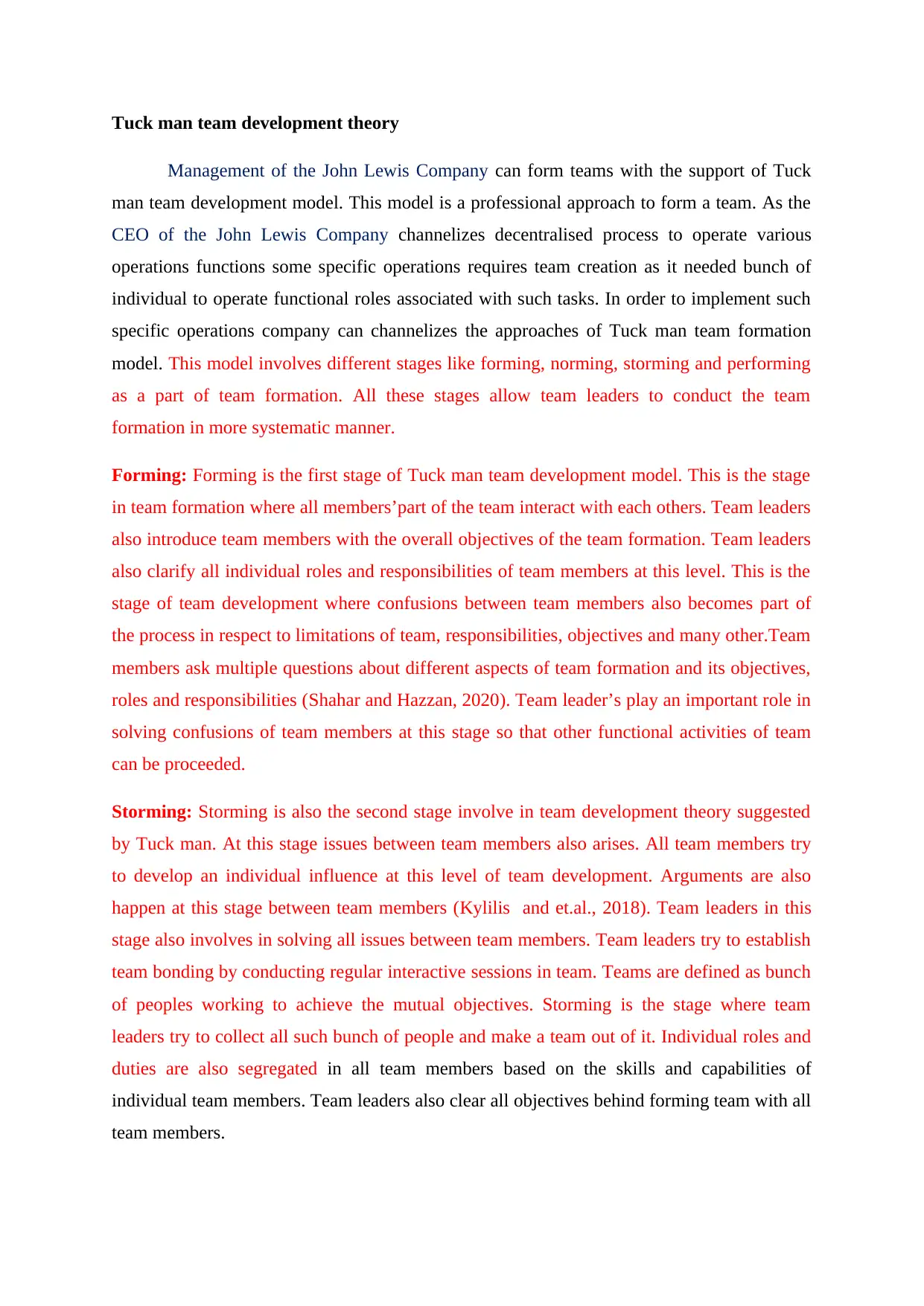
Tuck man team development theory
Management of the John Lewis Company can form teams with the support of Tuck
man team development model. This model is a professional approach to form a team. As the
CEO of the John Lewis Company channelizes decentralised process to operate various
operations functions some specific operations requires team creation as it needed bunch of
individual to operate functional roles associated with such tasks. In order to implement such
specific operations company can channelizes the approaches of Tuck man team formation
model. This model involves different stages like forming, norming, storming and performing
as a part of team formation. All these stages allow team leaders to conduct the team
formation in more systematic manner.
Forming: Forming is the first stage of Tuck man team development model. This is the stage
in team formation where all members’part of the team interact with each others. Team leaders
also introduce team members with the overall objectives of the team formation. Team leaders
also clarify all individual roles and responsibilities of team members at this level. This is the
stage of team development where confusions between team members also becomes part of
the process in respect to limitations of team, responsibilities, objectives and many other.Team
members ask multiple questions about different aspects of team formation and its objectives,
roles and responsibilities (Shahar and Hazzan, 2020). Team leader’s play an important role in
solving confusions of team members at this stage so that other functional activities of team
can be proceeded.
Storming: Storming is also the second stage involve in team development theory suggested
by Tuck man. At this stage issues between team members also arises. All team members try
to develop an individual influence at this level of team development. Arguments are also
happen at this stage between team members (Kylilis and et.al., 2018). Team leaders in this
stage also involves in solving all issues between team members. Team leaders try to establish
team bonding by conducting regular interactive sessions in team. Teams are defined as bunch
of peoples working to achieve the mutual objectives. Storming is the stage where team
leaders try to collect all such bunch of people and make a team out of it. Individual roles and
duties are also segregated in all team members based on the skills and capabilities of
individual team members. Team leaders also clear all objectives behind forming team with all
team members.
Management of the John Lewis Company can form teams with the support of Tuck
man team development model. This model is a professional approach to form a team. As the
CEO of the John Lewis Company channelizes decentralised process to operate various
operations functions some specific operations requires team creation as it needed bunch of
individual to operate functional roles associated with such tasks. In order to implement such
specific operations company can channelizes the approaches of Tuck man team formation
model. This model involves different stages like forming, norming, storming and performing
as a part of team formation. All these stages allow team leaders to conduct the team
formation in more systematic manner.
Forming: Forming is the first stage of Tuck man team development model. This is the stage
in team formation where all members’part of the team interact with each others. Team leaders
also introduce team members with the overall objectives of the team formation. Team leaders
also clarify all individual roles and responsibilities of team members at this level. This is the
stage of team development where confusions between team members also becomes part of
the process in respect to limitations of team, responsibilities, objectives and many other.Team
members ask multiple questions about different aspects of team formation and its objectives,
roles and responsibilities (Shahar and Hazzan, 2020). Team leader’s play an important role in
solving confusions of team members at this stage so that other functional activities of team
can be proceeded.
Storming: Storming is also the second stage involve in team development theory suggested
by Tuck man. At this stage issues between team members also arises. All team members try
to develop an individual influence at this level of team development. Arguments are also
happen at this stage between team members (Kylilis and et.al., 2018). Team leaders in this
stage also involves in solving all issues between team members. Team leaders try to establish
team bonding by conducting regular interactive sessions in team. Teams are defined as bunch
of peoples working to achieve the mutual objectives. Storming is the stage where team
leaders try to collect all such bunch of people and make a team out of it. Individual roles and
duties are also segregated in all team members based on the skills and capabilities of
individual team members. Team leaders also clear all objectives behind forming team with all
team members.
⊘ This is a preview!⊘
Do you want full access?
Subscribe today to unlock all pages.

Trusted by 1+ million students worldwide
1 out of 19
Related Documents
Your All-in-One AI-Powered Toolkit for Academic Success.
+13062052269
info@desklib.com
Available 24*7 on WhatsApp / Email
![[object Object]](/_next/static/media/star-bottom.7253800d.svg)
Unlock your academic potential
Copyright © 2020–2025 A2Z Services. All Rights Reserved. Developed and managed by ZUCOL.





